Exhibition Guide
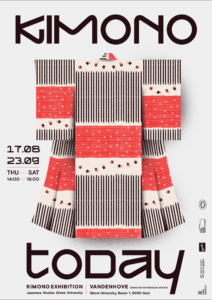
This exhibition showcases the variety of ways in which the kimono (lit. “things to wear”) is still present in contemporary Japanese society. The displays are divided into three sections: Formal wear, Work wear, and Casual wear, to help guide you through the range of kimono types and wearers, and the multitude of kimono-appropriate occasions. The kimono on display are part of the extensive private collection of Ms. Ruth Jäschke (Düsseldorf). We hope you’ll enjoy getting up close to the mannequins, to take in the carefully selected combinations.
Dressing in kimono includes more than you might imagine at first glance. First, you need several items and utensils in addition to the actual kimono itself. In the mid-section of the exhibition space,we have laid out the items that are indispensable for a finished kimono-outfit, most of which are usually not visible.
The combination of various pieces of clothing – and in particular the choice of the kimono, obi and obi accessories – requires careful consideration, since not everything is appropriate for every occasion (or age, etc.) Some kimono are decidedly formal, others clearly informal, yet in between there are some that can be dressed up or down, depending on the choice of obi and accessories. In knowing and playing within the frame of the rules, lies the true art of kimono-dressing, referred to as “kitsuke” in Japanese.
We understand very well how tempting it is to touch the sensuous kimono fabrics displayed within armlength, and therefore we have included two areas in the exhibition where you are allowed to ‘let yourself go!’ and freely touch and experience the many textures first-hand. In the entrance corner of the exhibition, you can see and feel the difference between various kimono fabrics. At the far end of the exhibition hall, you will find the obi-challenge room, where we dare you to try binding an obi yourself, under the guiding instruction of kimono sensei Nasu Natsuko.
We do ask you kindly to not touch any of the exhibits in other areas of the exhibition.
In between the kimono exhibits, you will encounter students’ photographs to show similar kimono in real-life settings, as well as interviews conducted by our students, to provide a deeper insight into the mindset of young Japanese people on the one hand and of a kimono professional on the other.
We hope that after visiting this exhibition you will have gained a new insight into the multifaceted culture of kimono in Japan today and a better understanding of its many possibilities of expression.
Your curators: Marlies Holvoet, Ruth Jäschke, Andreas Niehaus
The Exhibition
Atrium 2nd floor
Kaga Yūzen
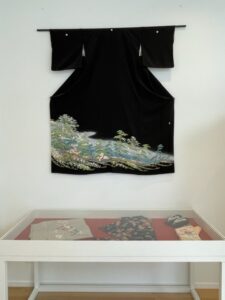
Ghent’s sister city Kanazawa is known for its wealth of traditional arts and crafts. One of these is Kaga-yūzen, a complex silk-painting technique that has been used to decorate high-end kimono for some 300 years.
What distinguishes Kaga-yūzen from Kyoto-style Kyō-yūzen is its distinctive colour palette of Kaga-gosai, or “the five Kaga colours”: indigo, crimson, yellow ochre, dark green and purple. No additional embellishments such as gold leaf or embroidery are used in Kaga-yūzen. A characteristic feature is the naturalistic depiction of flowers and plants, with a recognizable detail being the use of mushi-kui, in which leaves show spots and discolorations, as if eaten by insects.
Kaga-yūzen is recognized as a traditional craft in Japan. The authenticity of Kaga-yūzen is always certified by a label; red for tegaki-yūzen (literally, “hand-painted yūzen“) and purple for itaba-yūzen (literally, “board-yūzen,” which uses stencils to create repetitive patterns). Artists sign their work with an artist’s stamp (rakkan).
hung on kimono rod on the wall:
kuro-tomesode (highest-ranking kimono for married women) made of silk with five family crests (kamon; thus the highest level of formality) by the Kaga-yūzen artist TAKEBE Yoshinobu (武部良信):
- self-employed since 1989
- President’s Prize of the Kanazawa Chamber of Commerce at the 16th Kaga-yūzen Competition for New Works in 1990
- 1992: Advancement Award of the 19th Kaga-yūzen Color Festival
shows an impressive water and rocky landscape with pine trees, islands, old house, etc., possibly Kanazawa by the sea with its famous Kenroku-en garden (e.g. in the foreground with the fenced area and the ropes tied up, typical of the yukitsuri snow protection practiced there for the pine trees, with flowers and bushes); with artist’s stamp (rakkan)
in the glass vitrine:
- Wooden zōri sandals by Kaga-yūzen artist OKUDA Katsumasa (奥田 勝将) with floral decoration on the fabric-covered straps.
- black, small-patterned everyday kimono (komon) with colorful chrysanthemums, dyed using the Kaga-yūzentechnique, with an official Kaga-yūzen certificate of authenticity.
- hanhaba-obi (half-width kimono belt), sewn from fabric of a Kaga-yūzen-hōmongi (this a a beautiful example of how kimono fabrics can be recycled and re-used for other purposes and thus regain a new lease of life).
Main exhibition hall 2nd floor
1. Touch & Feel!
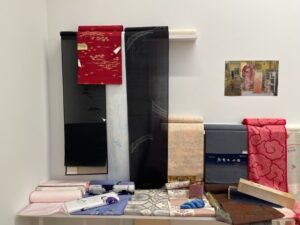
1.a Hung on kimono rod on the wall:
unused raspberry colored karieba furisode of the kind found in kimono shops: This silk kimono is not yet lined and sewn, so not ready to wear. Instead, the parts are only loosely sewn together at the main seams, so that the kimono can be adjusted to the size or measurements of its future wearer.
The material is silk with a woven floral pattern; partly dyed in shibori (tie dye technique similar to batik); with a decor of the four seasons (cherry blossoms, chrysanthemums, maple leaves, plum blossoms).
Since the kimono is tied up in the middle when worn and this area is covered by the wide kimono belt (obi), there is no decor in the middle part; the magnificent obi will later look particularly good here, since it does not have to compete with the decor of the kimono in this part.
1.b Kimono fabric display:
Take a look AND have a feel!
Here you can find (from left to right) some silks used for kimono undergarments. Next are light summer fabrics, including cotton used for yukata summer kimono on the table, and several silk gauzes hanging off the wall. Woven fabrics include heavier weaves to make obi, and some lighter ones meant for kimono. Kimono fabrics can be decorated with various dyeing techniques as well. Here you find some examples of shibori tie-dye in various shades of red and pink. Hand-painting can be used to create fine motives and decorations in certain areas of the fabric, or stencil-painting can cover the entire surface of the fabric.
1.c Kimono bolt (tanmono) presented as kimono:
These days prêt-à-porter kimono are becoming more and more common. But the traditional way of buying a kimono in a kimono shop, is to choose it from a bolt of kimono fabric called tanmono, like the ones on the fabric display. In order to get an impression of what a finished kimono will look like, a salesperson can drape the kimono bolt on the customer similarly as was done on the dummy here. That way the customer can see if they like the overall look and colour of the fabric on them.
On the lefthand side of the dummy, we’ve draped a fabric with an all-over small pattern – such overall small patterning is called “komon” -, which can be sewn up to make a casual kimono/for casual occasions. On the righthand side is a smooth painted and embroidered silk, which could be sewn up into a semi-formal kimono.
From here on out, we kindly ask that you refrain from touching any of the exhibits (except for the obi in the Obi-challenge room).
Raised platform in the mid-section of the exhibition hall
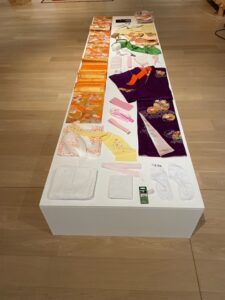
On this platform, we have laid out all necessary items that make up a complete kimono outfit:
- kimono socks (tabi)
- undergarment; possibly also a special kimono bra
- towel/towels for stuffing/padding curves
- under-kimono (nagajuban); here white with orange flowers
- collar stiffener (eri-shin)
- decorative collar (han-eri); here in yellow and embroidered
- different ribbons for fixing the under-kimono, e.g.mune-himoand wide, soft date-jime; here in pink
- kimono; here dark purpletsukesage
- coloured decorative collar (kasane-eri), which suggests another kimono layer; here in orange, woven in the auspicious swastika pattern +eri-clip for fastening to the kimono collar
- kimono clips as a fixation aid while getting dressed
- waist band (koshi-himo)to fix the kimono to the correct body length; here pink
- length-adjustable rubber band with clips on both sides (kōrin-beruto; here pink) to fix the kimono collar (alternativelymune-himo)
- kimono belt (obi); herefukuro-obimade of orange silk brocade with a floral pattern
- obiboard (obi-ita) to keep the obi nice and flat
- additional bands, rubber bands or similar to fix theobibinding
- obicloth (obi-age); here green
- obipillow (obi-makura) to give volume or stand to the obi binding
- obicord (obi-jime); here green-gold
- obibrooch (obi-dome), to be strung on the obi-jime as a finishing detail
- haorijacket, with adjustable cords to match the outfit; here in soft yellow to caramel-colour shibori tie-dye
- hair ornament
- kimono sandals (zōri)
- handbag
Formal Wear
2. hōmongi
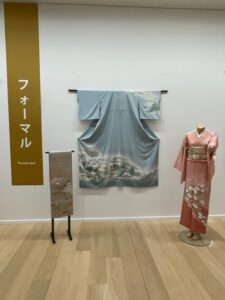
Hōmongi is a kimono with decorations on the sleeves, shoulders and bottom, which can be worn on semi-formal occasions.
2.a on obi rack:
fukuro-obi: silk with silver threads; Aristocrats in Heian period robes (Heian period: 794-1185/1192) play kemari (traditional Japanese version of soccer, in which the ball is played or plucked in such a way that it does not hit the ground) in a landscape with blossoming cherry trees, hills, a stream, chrysanthemums, maple leaves, bluebells, etc. – In terms of motif and color, this obi goes well with the light blue hōmongi that is hung next to it.
2.b hung on kimono rod on the wall:
light blue hōmongi depicting various scenes showing courtiers in Heian period robes admiring the cherry blossoms, walking etc. – hand-painted artwork in which silk becomes canvas. The woman wearing this kimono demonstrates her high sense of art and aesthetics as the decor is reminiscent of the Heian period (794-1185/92) with its court nobles who devoted themselves to art and culture. The white family crest (kamon; here showing the tachibana crest/wild tangerine) placed top center makes the kimono suitable for semi-formal occasions.
2.c on mannequin:
pink hōmongi with artist’s stamp (rakkan, not visible when worn with white peonies and the “Seven Autumn Flowers/Grasses” (aki no nanakusa), including bush clover (hagi), golden lace (ominaeshi), carnations (nadeshiko) and chrysanthemums (kiku).
A mother could wear such a cheerful, restrained kimono on the 7-5-3 festival in November when she goes to the Buddhist temple or Shinto shrine with her 3- or 7-year-old daughter or 5-year-old son to pray for their well-being and healthy growth.
- The woven kimono belt (obi) made of silk brocade with a decoration of plum blossoms and camellias already hints at winter.
- The wider obi cord (obijime) is typical for more formal occasions.
- The fresh green of the obi cloth (obiage) and the additional decorative collar (kasane-eri) visible narrowly on the collar give the kimono a fresh accent.
3. furisode
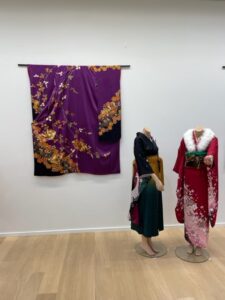
Two main occasions for young Japanese women to wear a kimono are when they come of age (seijin-shiki) and when they graduate from university. Then it’s time for the furisode, the young unmarried woman’s most formal kimono, designed to show off her youthful beauty to the fullest. Characteristic of the furisode are its particularly long sleeves, its often rich decoration and the lavish binding of the magnificent obi kimono belt.
3.a hung on kimono rod on the wall:
dark purple furisode made of fine, smooth rinzu silk (“Queen of silk”) with a rich gold-painted or framed decoration of bush clover (hagi), cherry blossoms (sakura), chrysanthemums (kiku), fan leaves, butterflies, hills
3.b on mannequin:
wine-red furisode made of silk with woven cherry blossoms, decorated with pink and white cherry blossoms and toy balls (temari), which stands for sweet, cute Japan and for a long time embodied the preferred image of a young woman.
- with a gold-black fukuro-obi, the binding of which cleverly plays with the golden front and the shiny black back, which forms a rose blossom.
- The obi is emphasized at the front by a lush green obi cloth (obiage) in shibori dyeing with golden butterflies and an obi cord (obijime), which picks up on different colors of the kimono and is tied particularly artfully.
- On the kimono collar, the decorative collar (han-eri) of the underwear kimono flashes, complemented by a golden decorative collar (kasane-eri).
- Since it is often cold at the coming-of-age celebration in January, the young lady has put on a white fur collar.
In her hand, the mannequin holds a real temari. These days, the delicate decorating of these toy balls is considered a traditional craft in Japan, and rather than as toys, temari are gifted as symbols of friendship or love from mothers to daughters. Originally though, they were made from a ball of scraps from an old kimono (sometimes a child’s first kimono), wound with the sewing threads unpicked from kimono that were taken apart to be washed or refitted.
3.c on mannequin:
black furisode made of smooth rinzu silk with a modern decor of green-pink-purple-turquoise peacocks and small flowers, combined – as is popular today with young Japanese women – with skirt pants (hakama) that fade from mustard yellow to dark blue-green, which allows the wearer more freedom of movement.
The collar part of the kimono is emphasized by the decorative collar (han-eri) of the underkimono, which picks up the colors of the kimono, and an additional blue-green, glittering, narrow collar (kasane-eri).
4. kuro-tomesode or iro-tomesode
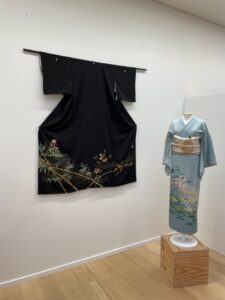
One of the most formal occasions in life is the wedding. In Japan, marriage is not only the private connection between two people, but also between their families and is often celebrated with family, friends and colleagues in a hotel with a wedding banquet. The ceremonial program is precisely timed and moderated according to a fixed schedule. Especially female family members, sometimes also girlfriends and other guests, wear a kimono appropriate to that occasion.
A kuro-tomesode or iro-tomesode is a kimono typical for ceremonial occasions. It is characterized by:
- decor only in the lower area (not on the sleeve as on the hōmongi)
- family crests (kamon) indicating the degree of formality – highest level: 5 kamon (see kuro-tomesode on the wall)
4.a hung on kimono rod on the wall:
kuro-tomesode (most formal kimono of the married woman) made of black silk with artist’s signature and artist’s stamp (rakkan; on the right front side, hidden under the left side of the kimono when worn), five family crests (kamon) indicating the highest formality (three at the back, two at the front) and a decor of plum blossoms, bamboo and a small samurai boy with a sword. The mother of the bride or groom would be dressed this way at the wedding reception: very formal, indicating the purity and beauty of the young bride (plum blossoms) and suggesting wishes or hopes (samurai boy = a brave male offspring; bamboo = longevity and ability to overcome all difficulties).
4.b on tailor’s dummy:
light blue iro-tomesode by kimono artist NOZAKI Tokushō (野崎徳勝) with butterfly family crest (kamon) and landscape in Kaga-yūzen coloring style; the artist’s stamp (rakkan) and the inscription「彩賀旅情」 areon the right front side and are optically hidden under the left side when worn. Such a kimono could, for example, be worn by the bride’s or groom’s sister or aunt at the wedding celebration, which is why a formal fukuro-obi in cheerful white with gold decoration in the traditional shōsōinpattern was chosen here, which emphasizes the ceremonial character.
The utensils for such formal occasions are also prescribed: white obi cloth (obiage) with gold embroidery, white and gold, wide obi cord (obijime; larger width stands for more formality)
5. uchikake
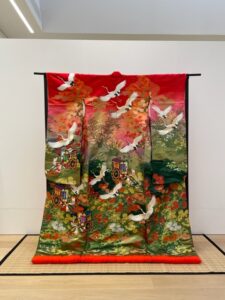
uchikake (wedding robe for the bride, worn over a furisode) fading from red to pink to green, with a padded hem, richly embroidered with a floral landscape full of auspicious motifs, e.g. cranes, chrysanthemums, bamboo, Heian-period ox-carts of the nobility.
6. Photos
At the back of the wall you will find photos of formal wear taken by students from the Institute For Japanese Studies during their time as exchange students in japan.
7. Kimono dressing (Kitsuke)
To dress oneself or someone else in kimono takes some skill, and since hardly anyone wears kimono on a daily basis anymore, this skill needs to be taught and acquired through lessons. Very much like with other Japanese ‘traditional’ art forms, there are many different kimono schools, which all have their own curriculum and rules for dressing properly. The art of kitsuke is not limited to putting on a kimono in the correct way, it is equally important to learn how to compose oneself when wearing a kimono, and to better oneself through continued practice.
7.a Interview with kimono sensei Natsu Natsuko
7.b in the showcase:
Here we’ve displayed some samples of kitsuke manuals and rulebooks. Although kimono schools are past their heyday, the ones who remain in business continue to evolve and innovate when it comes to kimono looks and fashion, while protecting some values thought essentially Japanese.
8. Obi Challenge Room
8.a Come in and welcome to the obi challenge room! Now that you have seen some fine examples of obi knots on the formal mannequins, we would like to challenge you to try your hand at this part of the kitsuke process yourself. You can choose the level of difficulty that suits your dexterity and tenacity. We have provided all utensils necessary + professional instruction videos with kimono sensei Nasu Natsuko for (almost) each level:
- diehard level: try tying a complex obi knot for a formal occasion, using a fukuro obi
- medium level: try tying a classic obi knot called taiko-musubi, using a nagoya obi, which is specially designed for this particular obi knot
- beginner level: try tying a half-width obi (hanhaba-obi) into a cute obi knot for a casual occasion, often used with cotton summer kimono (yukata)
- – cheat level: this pre-tied obi (tsuke-obi) is so easy to put on, it doesn’t even require instructions…
- – creative / artist / free spirit /rebel level: make up your own artistic obi knot and start a new rage!
- When finished, don’t forget to take a selfie and tag it, using #obichallengeGhent
8.b rokutsū-fukuro-obi (approx. 60% decorated fukuro-obi) made of silk brocade with scenes from the textile production: spinning & weaving
8.C Illustration of dressing-up and dressing-down a plain iro-muji kimono, from semi-formal to casual, by simply changing obi and obi accessories.
WORK WEAR
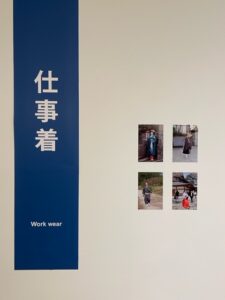
The photographs show (clockwise from top-left):
- Maiko (apprentice geisha) with a long trailing kimono for dancing.
- Buddhist monk on his begging round.
- Miko (Shintō shrine maiden) wearing kimono and hakama skirt-pants.
- Ikebana teacher — HIROTA-sensei would like to wear kimono casually more often, but finds there are few opportunities in Japan to do so. Instead, he dresses in kimono whenever he teaches ikebana overseas, even though kimono sleeves tend to be a bit cumbersome while arranging flowers.
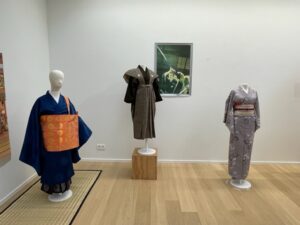
9. workwear on Mannequins
9.A Photographs of work wear taken by students from the Institute for Japanese Language and Culture during their time as exchange students in japan.
9.B on tailor’s dummy:
Jōdoshin-shū priestly robe: Consists of white undergarments, purple summer skirt pants (hakama), royal blue robe (shikie) and orange silk stole (gojō-gesa). This robe is worn at solemn ceremonies (except mourning or memorial ceremonies). Depending on the Buddhist school, there are different ceremonial garments. The priests of the Jōdoshin-shū are relatively free in their choice of color, so that stronger, brighter colors can also be found. (On loan from Prof. Dr. MATSUMARU Hisao, EKO Center of Japanese Culture, Düsseldorf)
9.C on tailor’s dummy:
Movie robe of a samurai actor in formal wear (kamishimo with hakama, plus brown kimono) with Takeda family crest (kamon); probably from the mid-20th century and relatively short; uma-nori hakama for riding a horse
9.D on tailor’s dummy:
washable, grey-lilac-colored polyester komon (everyday kimono in a continuous pattern) with floral decoration, here with a pre-tied obi (tsuke-obi) in the hakata weave (hakata-ori) typical of Fukuoka/Kyūshū, with Velcro fasteners so that the belt can be put on quickly and easily. Such a combination is worn, for example, by waitresses in traditional restaurants, perhaps also by a tourist guide, an employee in a traditional ryokan hotel or similar.
10. Teahouse Komako (on loan from Hogent/ Circular Design inspired by Japan, Dirk Van Gogh)
10.a self-sewn kimono by Mrs. Kyoko Ishii (1938 – )
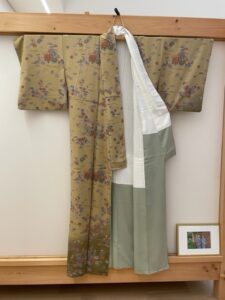
Mrs. Ishii is a shufu (full time housewife) with three children (two sons and a daughter). Since her husband was a big fan of Kimono, she started to learn to sew Kimono with a professional Kimono master. She has been making Kimono for about 50 years in her free time as a hobby. This piece of Kimono is called Homongi, literally “visiting dress”, which is put on for celebrating occasions. It was made more than 30 years ago.
10.b Komako Teahouse and Futures through Design
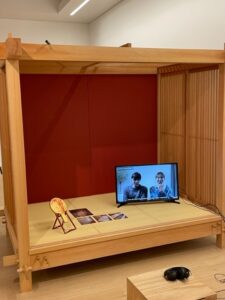
Small dismountable wooden house KOMAKO, OAK VILLAGE Co., Ltd.
- It is a disassemblable wooden pavilion based on traditional Japanese wooden architectural techniques, which creates a space surrounded by wood more than a piece of furniture, less than a piece of architecture.
OAK VILLAGE, Hida Takayama, Japan
- In the Hida Takayama region of Gifu Prefecture, surrounded by rich forests, the art of craftsmanship, repair and restoration using wood has been cultivated for over 1,000 years and the skills are known as ‘Hida Takumi’. Since 1974, Oak Village has been manufacturing, repairing and restoring wooden architecture, furniture and livingware based on traditional woodworking techniques and timeless design, making full use of Japanese local wood, aiming to create products that can be used for 100 years in its workshop in the Hida Takayama forest. https://www.oakv.co.jp/
Futures through Design (HOGENT, KASK & Conservatorium School of Art, Gent)
- ‘Future through Design’ Research Center proposes sustainable and tangible answers to society’s challenges through an open and creative research process around landscapes, cityscapes, interiors and objects, designing a future perspective to promote social and ecological transformation.
- ‘Circular Design inspired by Japan’ is a research project of Futures through Design, 2019-2022, which aims to reduce waste in the interior and furniture sector in Flanders, Belgium. Incorporating inspiration gained from traditional Japanese techniques – the cloth wrapping and tying technique of ‘Furoshiki’, the wood joining technique of ‘Kigumi’ and the paper folding technique of ‘Origami’, this research aimed to create ideas for a circular design based on ‘Design for Disassembly’ that is easy to dis- and reassemble to encourage better maintenance, reuse, refurbishment, and recycling of furniture.
- One of the outcomes is currently researched by Industrial Research Fund (IOF) ‘Innovative Design for Disassembly technology for circular furniture’ (2022-2024), in which the feasibility of ‘Design for Disassembly’ technologies for furniture and of its business models is being examined.
10.c Interview with Japanese exchange students staying in Ghent on their views on kimono
10.d Photographs of kimono storage in kimono chest of drawers (tansu), in paper slips (tatō-shi), holding on to family history
Casual Wear
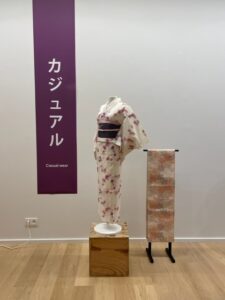
While relatively strict rules still apply to kimonos for formal and semi-formal occasions and kimonos used as workwear are usually subject to the specifications of the institution you work for, everyday kimonos give you more freedom in design options. As a result, they give more opportunity to reflect one’s personality and to show preferences. Perhaps this is one of the reasons why, on the second-hand market, everyday kimono paraphernalia can be just as expensive, if not more expensive, than the finer ceremonial paraphernalia. Many ladies, when they get older or get married, sell their formal furisode for lack of opportunity to wear it (therefore there are many relatively cheap offers for furisode on the second-hand market).
Kimono-lovers “style” the same everyday kimono again and again, for example by changing the han-eri (a decorative collar sewn onto the underkimono), which provides patterns and color accents instead of the plain white collar at the neckline. Or with a different colored obi cord (obijime) and obi cloth (obiage). Above all, however, the kimono belt (obi) – painted, woven and/or embroidered – can influence the overall impression of an often more simple everyday kimono much more than that of a magnificent garment for formal occasions, which in itself already attracts everyone’s attention.
The kimono belt (obi) – painted, woven and/or embroidered – can influence the overall impression of an often simpler everyday kimono much more than that of a magnificent garment for formal occasions, which in itself already attracts everyone’s attention.
II. SUMMER KIMONO
11.a on tailor’s dummy:
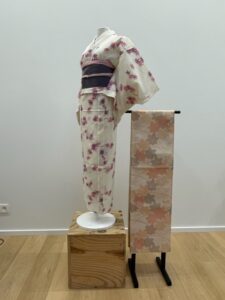
White, unlined summer kimono with decor of pink and purple maple leaves – The kimono decor either corresponds to the season you are in or – as here – heralds the next season: in the hot, muggy summer, the maple leaves give hope for the cooler, often sunny autumn.
- made of thin, slightly transparent fabric (usumono), as is usually worn in Japan in July and August with an equally semi-transparent under-kimono (nagajuban), which is adorned here with a special decorative collar (han-eri) with embroidered flowers.
- combined with an older purple vintage summer Nagoya obi, unlined and made of openwork fabric, with embroidered cicada – an insect whose male representatives can be heard everywhere in Japan in summer.
- The slightly transparent obi cloth (obiage) and the loosely braided obi cord (obijime) are also thinner than usual and are therefore geared towards the hot summer. Since they pick up on the purple of the maple leaves in color, a very harmonious overall picture is created.
11.b on obi stand:
Summer obi: unlined, woven in a slightly transparent manner, decorated with different colored maple leaves.
11.c on tailor’s dummy:
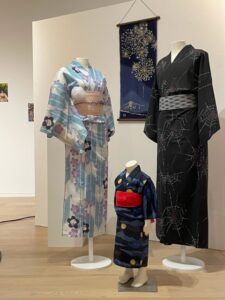
white yukata (unlined cotton kimono for summer, washable, mostly worn in July & August) for young womanwith Kitty-chan/Hello Kitty in cherry blossom decoration; the white and pale pink hanhaba-obi also shows small Kitty-chan and cherry blossoms, as can be seen clearly on the back in the obi binding known as ribon-musubi.
The ensemble is pimped up with a white tulle flower with rhinestones and a thin, glittering, purple-colored obicord (obijime) with transparent stones at the end, which picks up on the purple from the yukata.
The wearer has pushed the leaf fan (ogi) – an indispensable utensil in the hot and humid Japanese summer – behind the obi binding on the back to have her hands free, e.g. for a cool drink or the popular Japanese crushed ice with syrup (kakigōri).
11.d on tailor’s dummy:
dark yukata for man with cobweb decor that gives you the feeling of a spider crawling over your skin and is intended to give you a slight creep and cool you down. The grey-black obi is tied at the back in the simple form typical for men’s obi binding. It is considered cool to wear the obi slightly below the stomach – unfortunately our “model” is too slim…
11.e on baby dummy:
The yukata for a little boy shows that the decor caters to children’s favorite animals and preferences and current trends: be it teddy bears, cute little rabbits or… dinosaurs!
A typical children’s obi is a soft gauze heko-obi simply tied in a bow, which is quick and easy. This type of obimade of gauze is currently enjoying great popularity, especially among young women, as it is easy to shape and beautiful effects can be achieved easily as well.
Streetwear
In streetwear in particular, people often ignore traditional kimono rules and combine what they like. As in Western fashion, the trend here is also towards “crossover”: a break in style or a mix of different styles from different fashion worlds.
For example, wear leather boots or sneakers (instead of the usual kimono sandals), use a scarf (instead of the silk obiage), wear a leather belt (instead of the traditional braided silk obijime), or wear a more ornate obi that would normally be worn with more formal kimonos. You put on a skirt under the kimono (especially if it is an older, shorter kimono), combine the kimono with a turtleneck sweater, T-shirt, blouse or similar, add lace (e.g. lace collar, lace gloves) or put on a cap, beret or hat. A cute figure made of plastic or glass beads etc. can now serve as an obi brooch (obidome).
As a result, vintage kimonos that were inherited from older relatives or bought cheaply in second-hand shops or at flea markets can still be used. These kimonos are often too short for today’s Japanese women, but can then be tied higher and reused – worn in a modern way with boots, skirts or similar. They are pimped up, e.g. with a modern obi and fresh utensils (tulle petticoat, lace, etc.). Old kimono regulations, which were still strictly observed 20 years ago, are ignored – and sometimes even with the consent of professional kimono dressers in order to keep the kimono alive. The kimono has arrived in the 21st century…
By this, the kimono is more suitable for everyday use in today’s “modern” life and is easier to put on: If you wear a shirt under the kimono, the collar no longer has to sit quite as correctly. A skirt under the kimono gives more freedom of movement and allows for a looser, easier obi tie or even replacing the obi with a modern belt, etc. In addition, washable and durable fabrics such as polyester, viscose or denim are used by modern kimono designers.
12. Streetwear on Mannequins
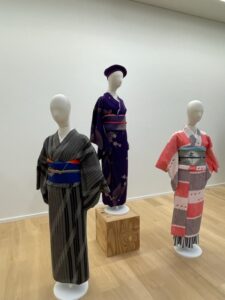
12.a simple, black, brown and white striped, unlined kimono (hitoe) made of a silk-wool blend (washable and hard-wearing): pimped up by
- royal blue Nagoya-obi with sparrow and ears of corn
- strong blue-red obi cloth (obiage) with lurex threads
- colourful, thick, round obi cord (obijime), usually used for formal furisode
- summer underkimono (since unlined kimonos are normally intended for the period June to September) with a delicately embroidered decorative collar (han-eri)
12.b lilac omeshi silk kimono from the 1940s with waves and flowers: here styled elegantly and at the same time modernly by combining with
- gold glitter shirt and white lace peeking out at the collar
- new fukuro-obi (signed by the artist) with a modern design of a street scene with houses
- red-pink thin obijime + shibori-obiage
- modern obi brooch (obidome) of a house
12.c white, unlined komon kimono from around the middle of the 20th century (retro style) with a décor of light red color fields and black lines, relatively short for today’s Japanese women: modernized by
- black and white striped pleated skirt peeking out at the bottom
- modern, gray fukuro obi with black and gold accents and kappa water spirits painted with a brush (see taikobinding on the back)
- turquoise shibori obi cloth (obiage)
- The spirit theme is taken up by a modern obi brooch (obidome) with a fox spirit mask on the blue obi cord (obijime)
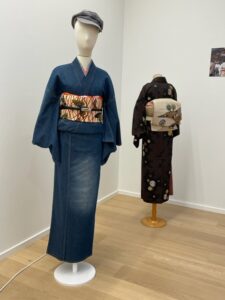
12.d blue, unlined, washed-out denim kimono (washable, durable & suitable for everyday use), pimped up by:
- gray-red-blue decorative collar (han-eri) with flowers on the underkimono
- orange-colored shibori obi cloth (obiage), which creates a connection to the light red in the decorative collar
- black leather belt
- Nagoya-obi in the bingata stencil-print design, tied at the back in the Ginza-musubi binding, which is considered to be particularly casual-cool
- light gray peaked balloon cap that takes up the gray of the decorative collar
For example, you could wear sneakers, gray canvas shoes or black leather boots
12.e 1950s brown omeshi silk kimono with large pink-orange, silver and gold dots: brought into the 21st century by
- new, off-white-brownish fukuro-obi with an embroidered cute landscape scene, which is tied in a taiko binding with a small fan sticking out on the left
- new, light green-pinkorange obi cloth (obiage)
- braided thin obi cord (obijime) made of faux leather
- The pinkorange color in the kimono and obi is picked up by the obi brooch (obidome) showing a Halloween pumpkin with a hat.
13. Slideshow of kimono streetwear
14. Photographs of casual ways to enjoy kimono today taken by students from the Institute for Japanese Studies during their exchange in Japan.
Atrium 2nd Floor
If you circle back to the atrium, you can see the last set of students’ photos, giving you an impression of contemporary kimono fashion shops, second hand kimono shops and kimono rental shops.
We also invite you to take a look at our book corner, with some kimono magazines and other kimono-related books to browse through.

With the support of:
VANDENHOVE Paviljoen, City of Ghent, Ghent University Faculty of Arts & Philosophy Internationalisation@Home, KASK, HOGENT, KOMAKO, Filou & Friends, Koninklijke Musea voor kunst en geschiedenis Brussels